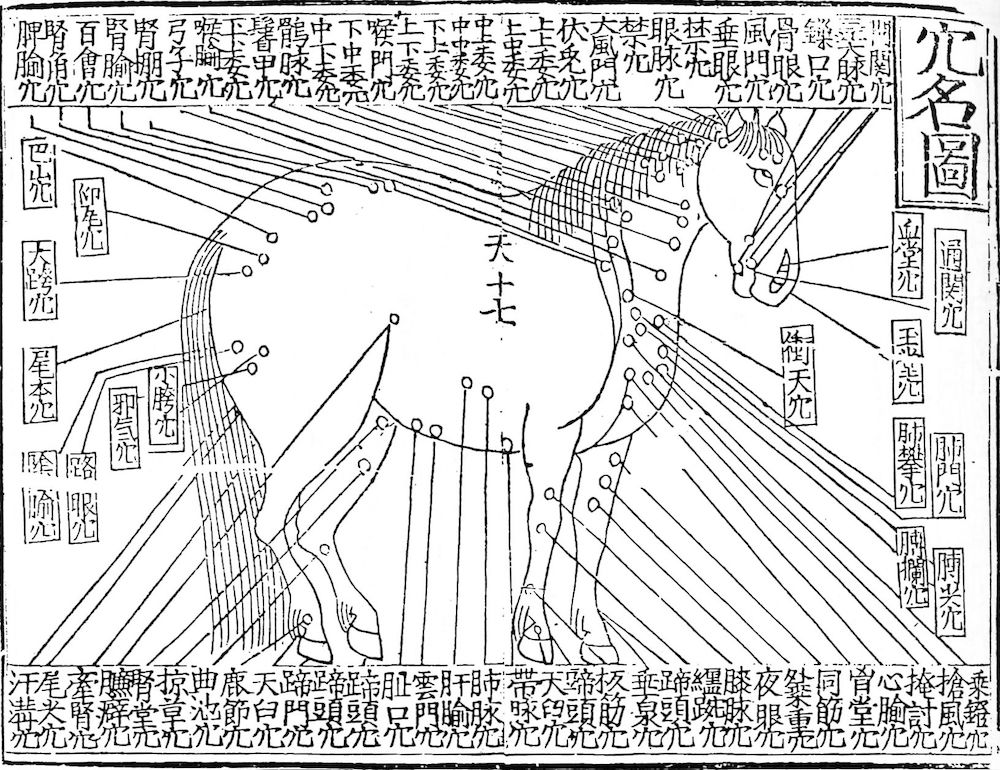Anjiji 安驥集, full title Simu anji ji 司牧安驥集 "The overseer of the pastures' book on curing bloodstock" is the earliest Chinese book on equine medicine. It was compiled during the Tang period 唐 (618-907) by Li Shi 李石 (783-845), who was Right Vice Director of the Imperial Secretariat (shangshu you puye 尚書右僕射) and Counsellor-in-chief (zaixiang 宰相). Around 838, Li was adjutant on campaign (xingjun sima 行軍司馬), and during that time acquired knowledge about equine medicine which he wrote down in a book of 4 juan of length.
The original text, consisting of 3 fascicles of general statements (Simu anji ji) and 1 fascicle of precepts (Simu anji fang 司牧安驥方) is lost. It was revised in 1134 by Feng Changning 馮長寧 and Lu Yuanbin 盧元賓. The part on the precepts was during the Song period 宋 (960-1279) circulating as a book of its own, with the title Anji yaofang 安驥藥方. During the Jin 金 (1115-1234) and Yuan 元 (1279-1368) periods, the text was enlarged to a length of 8 juan. This version included, among many others, Wang Yu's 王愈 Fanmu zuanyan fang 蕃牧纂驗方 from the Northern Song period 北宋 (960-1126), and the collections Huangdi bashiyi wen 黃帝八十一問 "Eighty-one questions to the Yellow Emperor" and Xintian ma qishi'er ehan bingyuan ge 新添馬七十二惡汗病源歌 "Newly added songs of the origins of seventy-two types of evil sweat". The most important Yuan-period editor was Zhang Muzhong 張穆仲, while Yang Sui'an 楊邃庵 and Che Ting 車霆 (jinshi degree 1481) were responsible for revisions of Ming-period 明 (1368-1644) editions. The best edition (shanben 善本) is the 1504 version.
The book was also transmitted to Japan, with the titles Bo Le zhen jing 伯楽針経, Simu anji ji-fang 司牧安驥集方, and Jiaming anji ji 仮名安驥集 (1604 edition with Furigana reading notes).
The book quotes from a treasury of older books on veterinary medicine, but brings their findings on the diagnosis and treatment of equine diseases into a more systematic pattern. Regarding the assessment of horses by inspection (xiangma 相馬), the book recommends a check of the pedigree, instead of relying exclusively on the physical determinants of the proband horse. The author discerns between 60 different races of horses, mainly determined by the structure of their coat.
The chapter Bo Le zhen jing 伯樂針經 is China's oldest text on the application of acupuncture for horses. Authorship is attributed to Bo Le (Sun Yang 孫陽), a famous horse tamer of the state of Qin 秦 during the Spring and Autumn period 春秋 (770-5th cent. BCE). The 77 acupuncture points (xuewei 穴位) listed are still used today in clinical veterinary medicine. The four chapters dealing with the five "hollow" zang viscera (wuzang 五臟, i.e. heart, liver, spleen, lung, and kidneys) contain elementary knowledge about the theory of the zang and "full" fu 腑 viscera and of the theory of meridians (jingluo 經絡) in animal medicine, and are therefore quoted by all later books on veterinary medicine. The author describes how to tell the age of a horse by the shape of its teeth (ch. Kouchilun 口齒論), and presents effective measures against tenosyvitis, an inflammation of tendon sheaths.
The diagnosis and prevention of equine diseases are the core of the book. For each disease, the text describes symptoms and characteristics. The details are found in the chapters Zao Fu bashiyi nanjing 造父八十一難經 "Zao Fu's book of 81 difficult diagnoses" (general discrimination of diseases), Kanma wuzang biandong xingxinang qishi'er dabing 看馬五臟變動形相七十二大病 "Seventy-two diseases by which the five organs change their appearance" (specific diagnosis and treatment), and the two above-mentioned chapters. There are four chapters specializing on causes of abdominal pain and of sore and toxic wounds. They are Sanshiliu qiwo bingyuan tuge 三十六起臥病源圖歌 "Illustrated songs of the origins of diseases of standing and lying", Qiwo rushou lun 起臥入手論 "Inserting the main [into the bowels]" (examining bowels, abdomen and faeces), Sanshiliu huang 三十六黃 "Thirty-six yellow sore spots (jaundice?)", Ershisi huang 二十四黃 "Twenty-four types of sore spots", and Chuangzhong bingyuan lun 瘡腫病源論 "On the causes of ulcers, carbuncles and tumours; venoms".
 |
1593 edition of the Chongkan Anjiji 重刊安驥集 by Zhang Shize 張世則. The edition consists of the parts Xinkan jiaozheng Anjij 新刊校正安驥集, Jianben zengguang buzhu Anjiji 監本增廣補注安驥集 3, Zengguang jianben buque zhujie Anjiji 增廣監本補闕注解 5-6, Xinkan zengbu Anjiji yaofang 新刊增補安驥集藥方 7, and Fanmu zuanyanfang 番牧纂驗方 1-2. |
The sections Anji yaofang 安驥藥方 and Fanmu zuanyan fang 蕃牧纂驗方 are texts on medical prescriptions dating from the Tang and Song periods many of which are used continuously. The part includes 25 treatment methods and 143 medical prescriptions.
The book retained its immense importance for the care of horses in the Chinese military and administration until the 18th century, when it was repaced by the book Niu-ma-tuo jing quanji 牛馬駝經全集. During the Song, Yuan, and Ming periods the book belonged to the basic teaching material for veterinary medicine, and was many times reprinted. Important annotated editions of the Ming period were published by the Directorate of Education (guozijian 國子監), the so-called Directorate editions (jianben 監本, zengguang jianben 增廣監本, and chongke zengguang jianben 重刻增廣監本), but only a few fragments of fascicles have survived. In 1957, the Zhonghua Shuju Press 中華書局 published the fragmentary 5-juan edition, and two years later, the Nongye Press 農業出版社 published a modern, annotated edition of 8 juan. The textual quality of the various editions differs widely, as editors heavily interferred into the selection of material.